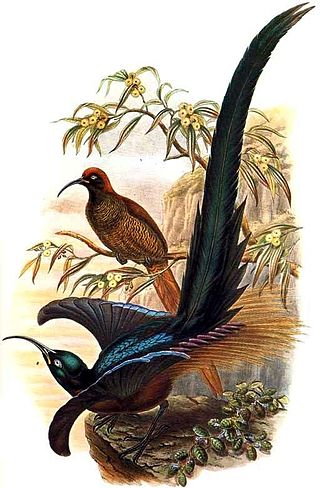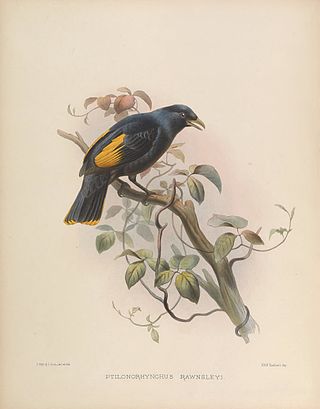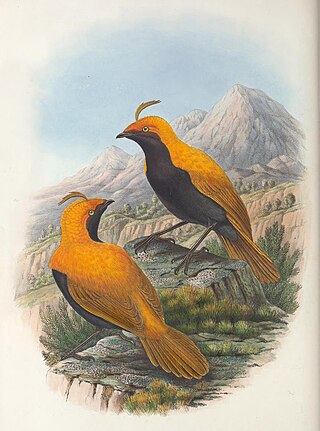Clifford Brodie Frith OAM (born 1949) is an Australian ornithologist and wildlife photographer. He and his wife Dawn Whyatt Frith have studied and published on Australian birds for many years, and publish books as Frith & Frith.
Clifford Brodie Frith OAM (born 1949) is an Australian ornithologist and wildlife photographer. He and his wife Dawn Whyatt Frith have studied and published on Australian birds for many years, and publish books as Frith & Frith.
Clifford Brodie Frith was born in 1949. [1]
In 2002 Frith obtained his PhD at Griffith University, Queensland, for his 1200-page thesis "Evolutionary studies of bowerbirds and birds of paradise: affinities and divergence".
Frith commenced his ornithological career at the Natural History Museum, London, where he worked from 1967 to 1970. Most of 1968 was spent in tropical Australia on the Fifth Harold Hall Australian Expedition to the Kimberley and Arnhem Land areas. He was resident ornithological staff scientist on Aldabra Atoll in the Indian Ocean for the Royal Society of London from 1972 to 1973. He then lived on Phuket Island in southern Thailand until moving the Australia to live.
Since 1977, Frith, with his wife Dawn W. Frith, has studied various aspects of tropical rainforest avifauna in Australia, New Guinea, and elsewhere for over three decades. His studies have resulted in many scientific publications on the behaviour, nesting biology, mating systems, and systematics of bowerbirds, birds of paradise, and other rainforest-dwelling bird species. He has produced two major ornithological text books: The Birds of Paradise: Paradisaeidae (1998), and The Bowerbirds: Ptilonorhynchidae (2004).
In July 1984 Clifford and Dawn Frith established their small publishing house (initially and briefly called Tropical Australia Graphics and then Frith&Frith Books).
The couple publishes wildlife photography books under the publisher name "Frith & Frith". [2]
(* = those works also illustrated by Clifford's photography)

The birds-of-paradise are members of the family Paradisaeidae of the order Passeriformes. The majority of species are found in eastern Indonesia, Papua New Guinea, and eastern Australia. The family has 45 species in 17 genera. The members of this family are perhaps best known for the plumage of the males of the species, the majority of which are sexually dimorphic. The males of these species tend to have very long, elaborate feathers extending from the beak, wings, tail, or head. For the most part, they are confined to dense rainforest habitats. The diet of all species is dominated by fruit and to a lesser extent arthropods. The birds-of-paradise have a variety of breeding systems, ranging from monogamy to lek-type polygamy.

Bowerbirds make up the bird family Ptilonorhynchidae. They are renowned for their unique courtship behaviour, where males build a structure and decorate it with sticks and brightly coloured objects in an attempt to attract a mate.

Wilson's bird-of-paradise is a species of passerine bird of the family Paradisaeidae.

The genus Paradisaea consists of six species of birds-of-paradise. The genus is found on the island of New Guinea as well as the nearby islands groups of the Aru Islands, D'Entrecasteaux Islands and Raja Ampat Islands. The species inhabit a range of forest types from sea level to mid-montane forests. Several species have highly restricted distributions, and all species have disjunct distributions. A 2009 study examining the mitochondrial DNA of the family found that the Paradisaea birds-of-paradise were in a clade with the genus Cicinnurus. It showed that the blue bird-of-paradise was a sister taxon to all the other species in this genus.

The Halmahera paradise-crow also known as the silky crow, is a medium-sized crow-like bird-of-paradise.

Epimachus is a genus of birds-of-paradise (Paradisaeidae) that includes two species, found in the highland forests of New Guinea. They are the largest members of the family. The common name "sicklebill" refers to their long, decurved, sickle-shaped bill.

The magnificent bird-of-paradise is a species of bird-of-paradise. The magnificent bird-of-paradise is evaluated as Least Concern on the IUCN Red List of Threatened Species. They are listed in Appendix II of CITES.

The brown sicklebill is a species of bird-of-paradise that is found in the mountain forests of New Guinea.

The greater lophorina, also known as superb bird-of-paradise or greater superb bird-of-paradise, is a species of the Paradisaeidae (bird-of-paradise) family. It was considered the sole species in the genus until in 2017 it was recognised that there were three species.

The golden bowerbird is a species of bird in the family Ptilonorhynchidae, the bowerbirds. It is endemic to Queensland in Australia, where it is limited to the Atherton region.

The spotted catbird is a species of bowerbird (Ptilonorhynchidae) which can be found in north Queensland, the eastern Moluccas and New Guinea. Although it is a member of the bowerbird family it does not build a bower.

The genus Ptiloris consists of four allopatric species of birds in the family Paradisaeidae. These birds of paradise are commonly known as riflebirds, so named for the likeness of their black velvety plumage to the uniform of the Rifle Brigade. Alternatively, the bird's cry is similar to a rifle being fired and hitting its target but a call like this is not commonly reported. They are distributed in the rainforests of New Guinea and Eastern Australia.

Manucodes are birds-of-paradise in the genus Manucodia that are medium-sized with black-glossed purple and green plumages.

The glossy-mantled manucode is a species of bird-of-paradise.
Dr Dawn W. Frith is an English born Australian citizen and ornithologist. She is now a self-employed private, independent, zoological researcher, consultant, natural history author, and publisher.
William Thomas Cooper was an Australian artist. William was born in Adamstown NSW Australia to Coral Bird and William Cooper. He had one brother, Buddy Cooper. He was originally a self-taught landscape and seascape artist but achieved renown through natural history scientific paintings, especially of birds. Cooper also became a taxidermist in his teenage years.
Blood's bird-of-paradise, also known as Captain Blood's bird-of-paradise, is a bird in the family Paradisaeidae that is a hybrid between a raggiana bird-of-paradise and blue bird-of-paradise. It is named after Captain N.B. Blood who obtained the specimen through his travels in the East.
Schodde's bird of paradise is a bird in the family Paradisaeidae that is an intergeneric hybrid between a Lawes's parotia and blue bird-of-paradise.

Rawnsley's bowerbird, also known as Rawnsley's satin bird or the blue regent, is a rare intergeneric hybrid between a satin bowerbird and a regent bowerbird.

The crested satinbird, formerly known as the crested bird-of-paradise, is a species of bird in the satinbird family Cnemophilidae. It is found in the mountains of Papua New Guinea.